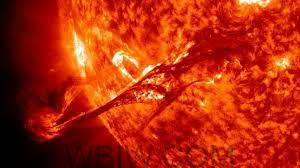
INDIANA – Warning – solar activity could cause geomagnetic storms on Friday strong enough to trigger disruptions to GPS, communications satellites, and some military radios.
“Geomagnetic storms can impact infrastructure in near-Earth orbit and on the surface, potentially disrupting communications, the electric power grid, navigation, radio, and satellite operations,” NOAA’s Space Weather Prediction Center explained in its warning.
While the United States celebrated Independence Day on July 4, the sun held its own, more powerful firework display.
The stellar fireworks came in the form of two solar storms, or coronal mass ejections (CMEs), — large explosions of plasma from the sun’s atmosphere, or corona that are partly directed at Earth.

CMEs create as much as a billion tons of plasma containing charged particles that create their own magnetic fields. These fields can slam into the Earth’s own magnetic field and wreak havoc.
NASA has projected that the massive ejection of ionized gas will impact Earth by Friday, July 7. When the charged particles within CMEs strike the magnetic field of our planet it will cause large disturbances called geomagnetic storms.
These storms can disrupt power and communication infrastructure in addition to affecting satellites, which could adversely influence services such as the global positioning system (GPS).
NASA predicted one CME storm will be slower and will arrive before 8 a.m. (EDT) on Friday and will head mostly to the northeast.
The second storm will catch up to the first giving us a 1,2-punch.
The second CME is hurtling through space more rapidly and will result as more of a “direct hit” on Earth, with it veering slightly southward.

When charged particles travel down the magnetic field lines in Earth’s magnetosphere, they create bright, colorful displays called auroras. These are usually only visible at high latitudes on Earth near the poles, but these powerful CMEs could give rise to auroras that are visible at lower mid-latitudes.
The NOAA adds that auroras connected to the geomagnetic storms can be seen in the U.S. as far south as Michigan and Maine.
Information: https://www.space.com/.



